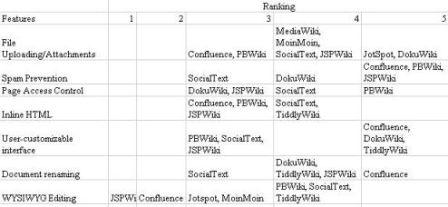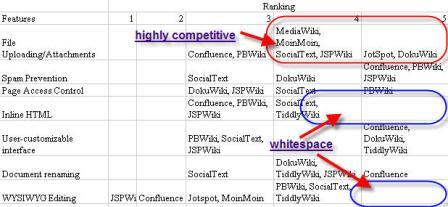This post suggests a technique for analyzing competition & feature comparison against competitive products. If there is a better name for this, feel free to suggest.
Ignorance is definitely not bliss for a startup CEO when it comes to sizing up the competition. You have to know the other players in the business, what they are doing, what products & features they have and what markets they are operating in. When you propose your product/plan/idea to prospective employees or investors — the first thing which goes in their mind is ‘scanning the competitive landscape.’
There are several traditional ways of sizing up the competition, including (a) drawing MxN matrices with company names on the left & features on the top and simply a (b) 2×2 quadrant (eg. Gartner’s magic quadrant) with companies plotted in clusters using 2 broad parameters. The picture below shows the traditional MxN style competitive analysis comparing Wikis (on the left) and their features (on the top):
Competitive Density Matrix is a different way of sizing up the competition. The perspective is to turn the matrix inside out by plotting features on the left and weights (Bad, Average, Excellent) on the top. You mark the companies at the intersection (cells) based on your knowledge of who are the companies and what is their depth of implementation of that feature. Here is the outline comparing the wiki platforms with ratings. The companies are entered in the cells. The traditional MxN competitive matrix can be re-purposed as below:
After you have “plotted” the companies against the features, next is the analysis to detect cells which have higher occupancy while some have none. Here is a an analysis:
The analysis from the above example of the wikis shows us “whitespaces” and “heavily competitive spaces” as follows:
- The File uploading feature in various Wiki software is implemented by everybody and is mature
- The inline HTML feature requires strengthing up so does the wysiwyg feature
The objective which competitive density matrix helps you achieve is:
- Drilling down into the features which you are planning to build in your product and size them up against your competition
- It goes beyond the broad level quadrants and simple Yes/No analysis but helps you assess which areas have been zeroed in by other players
- If the white space you see corroborates with a customer feedback or gap or a unique IP you have built, that could be a good differentiator


